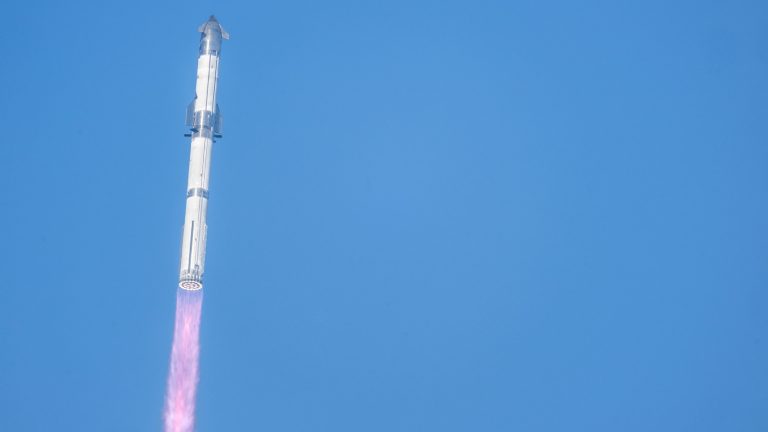SpaceX launched its Starship spacecraft Tuesday after two recent test flights resulted in the destruction of the spacecraft and sent debris falling back to Earth.
The unmanned ninth test flight of Starship from SpaceX’s Starbase facility near Brownsville, Texas, launched a few minutes after 7:30 p.m. ET, after a brief delay just before lift-off.
The launch is seen as a key step in Elon Musk’s goal to eventually send humans to Mars. But before SpaceX and NASA can send astronauts to the red planet, the company must prove Starship can fly and return safely and reliably.

SpaceX’s next-generation Starship spacecraft atop its Super Heavy booster is prepared for launch on its ninth test at the company’s launch pad in Starbase, Texas, May 27, 2025.
Joe Skipper/Reuters
During Starship’s eighth flight test in early March, several engines shut down unexpectedly about 5 1/2 minutes into the launch, resulting in SpaceX losing control of the craft. Communication with the vehicle was lost several minutes later.
After an investigation, the company said a “hardware failure” with one of the engines caused fuel to mix and ignite where it shouldn’t have. And while the ship wasn’t instructed to self-destruct, SpaceX says it likely did so automatically.

SpaceX Starship Flight 8 launches from Orbital Launch Pad A at Boca Chica beach, March 6, 2025, in Boca Chica Beach, Texas.
Brandon Bell/Getty Images
As Starship broke up, debris fell across South Florida and parts of the Atlantic, leading to ground stops at nearby airports. Photos and videos shared on social media showed rocket debris streaking across the sky.

SpaceX Starship’s Super Heavy Booster approaches the launch pad at Starbase near Boca Chica, Texas, March 6, 2025, during its 8th test flight.
Ronaldo Schemidt/AFP via Getty Images
A similar failure occurred in January when stronger-than-expected vibrations caused a propellant leak and explosion. In both cases, the upper stage was lost, but the first-stage booster was successfully returned to the launch site and caught using giant robotic “chopsticks” attached to the launch tower.
SpaceX says it has made significant modifications to the upper stage based on what it learned from previous flight tests and noted that while both failures occurred around the same time during the missions, the causes were unrelated.
No astronauts were aboard the previous missions, and none will be on board this time.
To reach orbit, Starship is mounted atop a 400-foot Super Heavy rocket powered by 33 Raptor engines, making it the most powerful rocket system ever developed, according to the company. Unlike the partially reusable Falcon 9, SpaceX aims for Starship to be fully reusable and capable of launching, landing and flying again with minimal maintenance.
According to SpaceX, this test will mark “the first launch of a flight-proven Super Heavy booster,” one that flew and returned during the seventh test flight. The company says 29 of the booster’s 33 engines will also be reused from the previous test. Engineers inspected and replaced known single-use components like the heat shield but left the booster mostly intact to study real-world wear and tear.

A SpaceX Falcon 9 rocket launches the National Reconnaissance Offices (NRO) NROL-153 mission from Space Launch Complex 4 East (SLC-4E) at Vandenberg Space Force Base, Jan. 9, 2025, in Lompoc, Calif.
Kirby Lee/Getty Images
The booster won’t attempt a return to the launch site this time. Instead, it will follow a modified flight path and “land” with a hard splashdown in the Gulf after testing new flight and landing configurations. One of the booster’s engines will also be disabled during the final landing burn to determine whether a backup can compensate.
The Starship upper stage will aim to complete objectives that eluded SpaceX during the previous missions, such as deploying eight Starlink satellite simulators, which would be a first for Starship, and performing a relight of a Raptor engine in space.
The spacecraft will also undergo extreme heat testing. Engineers have removed some of the thermal tiles used to protect the vehicle during reentry, exposing vulnerable areas on purpose, the company said. Different tile options and materials will also be tested during the launch.
“Developmental testing by definition is unpredictable. But by putting hardware in a flight environment as frequently as possible, we’re able to quickly learn and execute design changes as we seek to bring Starship online as a fully and rapidly reusable vehicle,” SpaceX said in its launch announcement.



